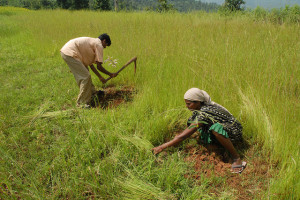Cross-posted from A4NH Gender-Nutrition Blog

Photo by BAIF Foundation, Maharastra, India. Source: Flickr (Climate Change, Agriculture and Food Security)
This month we’re continuing a conversation we started in May with two gender researchers from the CGIAR Research Program on Policies, Institutions, and Markets (PIM). Cheryl Doss, an economist at Yale University, and Caitlin Kieran, Senior Research Assistant on gender for PIM at the International Food Policy Research Institute, tell us a bit more about the contribution of sex-disaggregated data in agriculture, nutrition and health research. If you missed the first post on sex-disaggregated data, you can catch up here.
Question #4: What are some typical causes of error, and resulting consequences, that you have observed over the years in sex-disaggregated data collection and interpretation? Do you have any tips to share with our readers on how this can be avoided?
The most common problem in collecting sex-disaggregated data is that researchers add a few questions or interview both men and women without considering the research question that they are trying to answer. This results in two problems. First, the data collected ends up not being appropriate and researchers may not be able to answer the relevant research questions. Second, while researchers provide some descriptive statistics on men and women, they do no further analysis. The time and resources spent collecting the data are wasted because they were simply an add-on, not a part of the core research. Good qualitative data collection and analysis before the quantitative data collection begins can identify key areas in which sex-disaggregated data are needed to answer the research question and can identify ways in which understanding gender relations may alter the hypotheses to be tested.
For example, in one survey, our original intent was to interview the main farmer and his or her spouse about land ownership and production issues. With this information, we planned to analyse how land ownership affects productivity and how this differs for male and female farmers. But, the individual level questions were dropped from the farmer survey. Instead, the main farmer was asked only about household-level land ownership and production. The second person, who was not the primary farmer, was then asked about his or her individual rights over land.
In another survey about women’s empowerment in agriculture, a man and a woman were interviewed in each household. Unfortunately, their relationship was not linked to the information in the household roster. We would expect that the attitudes of a woman’s father would have a different impact on her empowerment than those of her husband. But it was impossible to identify these differences without the information on their relationship to one another.
Question #5: Can you give an example from your own research when your use of sex-disaggregated data led to a significant “a-ha!” moment that was surprising, either for the research team, a program implementation team, a policy maker, or some other decision maker?
In the Gender Asset Gap Project, we collected sex-disaggregated data on asset ownership and control in Ecuador, Ghana, and Karnataka, India. We had expected that when women owned land, they would be more involved in agricultural decision-making. And while this pattern generally holds, it varies across location, agricultural decision, partnership status (whether the woman is married or in a consensual union), and the type of ownership (whether the land is owned individually or jointly with someone else). For example, in Ecuador our results suggest that land rights may give women the opportunity to opt outof agricultural production as their primary activity, as many of these women are not involved in the decision over what to cultivate, yet they remain involved in decisions about the income generated from their plots. It is important to recognize that not all women (or men) who have land rights necessarily want to be involved in agricultural decision making, but the income generated as a result of their land rights may enhance their ability to pursue alternative activities.



